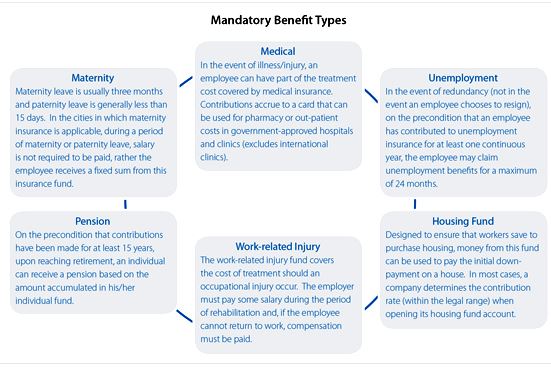Sublime Text 2 is a text editor for OS X, Linux and Windows, currently in beta.

 Social Insurance Compliance in China, Insurance Compliance at Koyal Group
Social Insurance Compliance in China, Insurance Compliance at Koyal Group

The social security system in China consists of five different types of insurance, plus one mandatory housing fund, introduced in the chart below. How companies register and deregister their employees often varies depending upon the city and the employee’s location or residency. In many large cities (with some notable exceptions such as Beijing), the registration and deregistration of most employees can be completed online. Similar to withholding tax, companies can make monthly contributions to the fund via direct debit. Many city governments, however, also restrict which banks are able to facilitate the transaction. At the present time, local Chinese banks can facilitate these transactions and businesses should verify which banks are approved by the local government to do so in their area of operation.

This article is an excerpt from the January and February 2014 issue of Asia Briefing Magazine, titled “Payroll Processing Across Asia.” In this issue of Asia Briefing Magazine, we provide a country-by-country introduction to how payroll and social insurance systems work in China, Hong Kong, Vietnam, India and Singapore. We also compare three distinct models companies use to manage their payroll across various countries with external vendors, and explain the differences among three main models: country-by-country, managed, and integrated models while highlighting some benefits and drawbacks of each.
Dezan Shira & Associates is a specialist foreign direct investment practice, providing corporate establishment, business advisory, tax advisory and compliance, accounting, payroll, due diligence and financial review services to multinationals investing in emerging Asia. Since its establishment in 1992, the firm has grown into one of Asia’s most versatile full-service consultancies with operational offices across China, Hong Kong, India, Singapore and Vietnam as well as liaison offices in Italy and the United States.
For further details or to contact the firm, please email asia@dezshira.com, visit www.dezshira.com, or download the company brochure.
You can stay up to date with the latest business and investment trends across Asia by subscribing to Asia Briefing’s complimentary update service featuring news, commentary, guides, and multimedia resources.

 Holding ALT while pressing up/down buttons should jump 2-3 (or a configured amount) rows instead of only 1
Holding ALT while pressing up/down buttons should jump 2-3 (or a configured amount) rows instead of only 1
i really miss a feature like this, currently (atleast that i know) you can only jump 1 row or to the end/start of the document using the cmd key (on mac).

 Give the 'find' window a separate context for each tab
Give the 'find' window a separate context for each tab
Frequently, I want to simultaneously jump through the occurrences of a searched-for string or regex (via the find window at the bottom of the screen) in one tab, while jumping through the occurrences of a *different* searched-for string or regex in another tab. Currently, this is a big hassle, since the 'find' window has a single context that is shared among all tabs.
For concrete example, suppose I have Tab 1 and Tab 2 open. In Tab 1, I want to walk through the occurrences of the string 'foo', and in Tab 2, I want to walk through the occurrences of the string 'bar':
- I use the 'find' window at the bottom to find 'foo' in Tab 1.
- I switch to Tab 2, and use the 'find' window at the bottom to find 'bar'.
- I switch back to Tab 1, and want to move to the next occurrence of 'foo'. If I use the 'find next' action, instead of moving to the next occurrence of 'foo', I move to the next occurrence of 'bar' in Tab 1! Instead, I have to type my search query (the string 'foo') again.
- I switch back to Tab 2, and the same issue occurs.

 vi interface
vi interface

 Unable to hide OS X scrollbar *when scrolling* in Sublime Text 2 (Mountain Lion)?
Unable to hide OS X scrollbar *when scrolling* in Sublime Text 2 (Mountain Lion)?
Since the OS X scrollbar defeats the purpose of the minimap (which is a scrollbar by itself), I want the OS X scrollbar to stay hidden *when scrolling* as well – not just in non-scrolling mode.
"overlay_scroll_bars": "enabled" doesn't work, since it shows up when scrolling. Is there any other solution?

 Remember active cell in layout after opening a saved project
Remember active cell in layout after opening a saved project
It would be better to have to focus in the same cell I left the project before.
This would also be more comfortable when fast switching between projects.

 Enable scrolling in long menus
Enable scrolling in long menus

 Crown Capital management environmental monitoring Watch 60 Years Of Climate Change In 15 Seconds
Crown Capital management environmental monitoring Watch 60 Years Of Climate Change In 15 Seconds
“Long-term trends in surface temperatures are unusual and 2013 adds to the evidence for ongoing climate change,” GISS climatologist Gavin Schmidt said. “While one year or one season can be affected by random weather events, this analysis shows the necessity for continued, long-term monitoring.”
The NASA data finds that with the exception of 1998, the 10 warmest years in the 134-year record have all come since the latest turn of the century, with 2010 and 2005 ranking as the warmest years on record.
To drive the point home, GISS created the below animation that shows the increase in temperatures worldwide over the past 60 years, compiled from data collected by over 1,000 meteorological stations around the globe.
A release from NASA makes the case that the increase in temperatures over the long-term is more a social problem than a matter of eons-long natural climate patterns:
Driven by increasing man-made emissions, the level of carbon dioxide in Earth’s atmosphere presently is higher than at any time in the last 800,000 years.
This summer, NASA plans to launch the Orbiting Carbon Observatory with the goal of studying both natural and manmade sources of carbon dioxide, one of the gases believed to be largely to blame for climate change.
Watch 60 Years Of Climate Change In 15 Seconds
According to NASA, 2013 was tied (with 2009 and 2006) for seventh warmest year globally on record, dating back to 1880. NASA scientists have played a leading role in climate research in recent decades and the agency’s Goddard Institute for Space Studies (GISS) this month updated a report analyzing worldwide surface temperatures.
“Long-term trends in surface temperatures are unusual and 2013 adds to the evidence for ongoing climate change,” GISS climatologist Gavin Schmidt said. “While one year or one season can be affected by random weather events, this analysis shows the necessity for continued, long-term monitoring.”
The NASA data finds that with the exception of 1998, the 10 warmest years in the 134-year record have all come since the latest turn of the century, with 2010 and 2005 ranking as the warmest years on record.
A release from NASA makes the case that the increase in temperatures over the long-term is more a social problem than a matter of eons-long natural climate patterns:
Driven by increasing man-made emissions, the level of carbon dioxide in Earth’s atmosphere presently is higher than at any time in the last 800,000 years.
This summer, NASA plans to launch the Orbiting Carbon Observatory with the goal of studying both natural and manmade sources of carbon dioxide, one of the gases believed to be largely to blame for climate change.

 Optional automatic backups while editing, maybe every N minutes or N edits
Optional automatic backups while editing, maybe every N minutes or N edits
Service d'assistance aux clients par UserEcho


